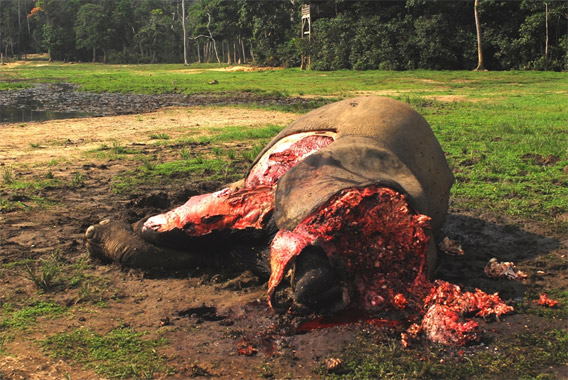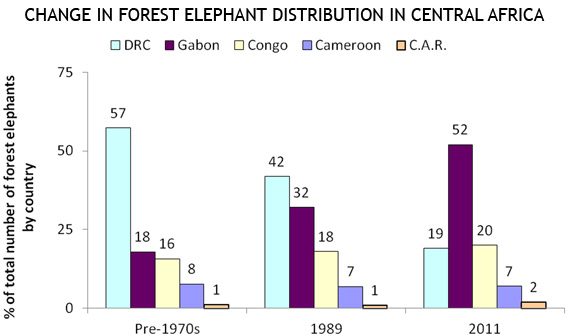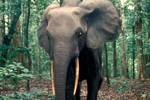
Forest elephant in Gabon
More than 60 percent of Africa’s forest elephants have been killed in the past decade due to the ivory trade, reports a new study published in the online journal PLOS ONE.
The study warns that the diminutive elephant species — genetically distinct from the better-known savanna elephant — is rapidly heading toward extinction.
“The analysis confirms what conservationists have feared: the rapid trend towards extinction – potentially within the next decade – of the forest elephant,” said study co-author Samantha Strindberg of the Wildlife Conservation Society (WCS).
“Saving the species requires a coordinated global effort in the countries where elephants occur – all along the ivory smuggling routes, and at the final destination in the Far East,” added co-author Fiona Maisels, also of WCS. “We don’t have much time before elephants are gone.”
The study is based on the largest-ever set of survey data across five forest elephant range countries: Cameroon, Central African Republic, the Democratic Republic of Congo, Gabon and the Republic of Congo. The study involved more than 60 scientists who spent 91,600 person-days surveying for elephants, walking over 13,000 kilometers (more than 8,000 miles).

A dead forest elephant with its tusks removed by ivory poachers. Photo credit: Andrea Turkalo/WCS.
The study shows that elephants are increasingly scarce in areas with “high human density, high infrastructure density such as roads, high hunting intensity, and poor governance”, according to a statement from WCS.
“Historically, elephants ranged right across the forests of this vast region of over 2 million square kilometers (over 772,000 square miles), but now cower in just a quarter of that area,” said co-author John Hart of the Lukuru Foundation. “Although the forest cover remains, it is empty of elephants, demonstrating that this is not a habitat degradation issue. This is almost entirely due to poaching.”
The decline in elephant populations has significant implications for the forest ecosystem. Elephants are considered “architects of the forest” for the role in opening clearings and maintain trails.
“A rain forest without elephants is a barren place,” explained Lee White. “They bring it to life, they create the trails and keep open the forest clearings other animals use; they disperse the seeds of many of the rainforest trees – elephants are forest gardeners at a vast scale. Their calls reverberate through the trees reminding us of the grandeur of primeval nature. If we do not turn the situation around quickly the future of elephants in Africa is doomed. These new results illustrate starkly just how dramatic the situation has become. Our actions over the coming decade will determine whether this iconic species survives.”

Percentage breakdown of the total number of forest elephants by country: for 3 time periods: pre-1970s and 1989 and 2011. Courtesy of Maisels et al (2013)
The study comes as representatives from 178 countries are gathered at the Convention on International Trade in Endangered Species of Wild Fauna and Flora (CITES) meeting in Bangkok to debate wildlife trade issues, including the ivory market. Critics of the ivory trade say the current system, where legal ivory is often used to provide a cover for black-market ivory, isn’t working, citing the rapid increase in elephant poaching. It is estimated that more than 50,000 elephants were poached in the last year alone for their tusks. Demand primarily comes from East Asia, especially China, Taiwan, Vietnam, Thailand, and the Philippines.
Addressing demand is increasingly seen as a top priority for elephant conservation.
“This study provides unequivocal evidence of the rapid demise of one of the planet’s most charismatic and intelligent species,” said George Wittemyer of Save the Elephants and Colorado State University. “The world must wake up to stem this destruction of species due to conspicuous consumption.”
CITATION: Maisels F, Strindberg S, Blake S, Wittemyer G, Hart J, et al. (2013) Devastating Decline of Forest Elephants in Central Africa. PLoS ONE 8(3): e59469. doi:10.1371/journal.pone.0059469
Related articles
Thailand’s Prime Minister commits to ending ivory trade

(03/04/2013) Yesterday, Thailand’s Prime Minister, Yingluck Shinawatra, committed to ending the ivory trade in her country. Her announcement came during the opening of the Convention on the International Trade in Endangered Species of Fauna and Flora (CITES) in Bangkok, which seeks to regulate trade in biodiversity across borders. Wildlife groups say that Thailand’s legal trade in domestic ivory—international ivory is illegal of course—has created an easy opening for smugglers from abroad. Currently the ivory trade in Thailand is estimated to be second only to that of China.
Elephant and Rhino issues to be debated at CITES 16th Conference of Parties
(03/04/2013) When the Convention on International Trade in Endangered Species of Wild Fauna and Flora (CITES) meets from March 3-14 in Bangkok for its 16th Conference of Parties (CoP16), elephants and rhinos will be at the top of the agenda. While there are no proposals to open up trade in either elephant ivory or rhino horn, there are several other items on the agenda that will likely generate debate, including proposals for extension of the moratorium on ivory trade, a decision-making mechanism for ivory trade, and suspension of any rhino trophy hunting. Also to be discussed are enforcement mechanisms, including how to prevent illegal ivory from entering existing legal domestic markets.
Elephant massacre in the Democratic Republic of the Congo
(02/28/2013) A key Congo wildlife reserve has lost 75 percent of its elephants in just 15 years due to poaching to meet Asian demand for ivory, reports a new survey by the Wildlife Conservation Society (WCS) and Democratic Republic of Congo authorities.
Over 11,000 elephants killed by poachers in a single park [warning: graphic photo]
(02/06/2013) Surveys in Gabon’s Minkebe National Park have revealed rare and hard data on the scale of the illegal ivory trade over the last eight years: 11,100 forest elephants have been slaughtered for their tusks in this remote protected area since 2004. In all, poachers have cut down the park’s elephant population by two-thirds, decimating what was once believed to be the largest forest elephant population in the world.
Religion, Chinese government drive global elephant slaughter

(01/24/2013) By some estimates, more than 30,000 elephants were slaughtered across the savannas and forests of Africa and Asia for the ivory trade during 2012. The carnage represents as much as 4 percent of the world’s elephant population. Accordingly, some conservationists are warning that elephants face imminent extinction in some of their range countries. While the plight of elephants is increasingly visible due to media coverage, less widely understood is the role religion plays in driving the ivory trade. This issue was explored at length in an explosive cover story published in National Geographic by Bryan Christy last October. The story, titled Blood Ivory, detailed how demand for religious trinkets is driving large-scale killing of Earth’s largest land animal.
Why it’s time to ban the ivory trade for good [Graphic images: viewer discretion advised]

(12/12/2012) This week the Kenya Wildlife Service (KWS) announced a 14% decline in elephants in the Samburu/Laikipia ecosystem over the last 4 years. The decline has occurred in a population whose natural growth rate was measured at 5.3% between 2002 and 2008 according to the previous survey, suggesting that over 300 elephants are dying annually in the Samburu and Laikipia’s landscape, denting the poster child image of one of Kenya’s most important wildlife landscapes. Poaching and drought are the main causes of mortality in this population. The impact of poaching on tourism cannot be ignored, heavily armed bandits threaten more than elephants, if we can’t protect elephants how can we protect international tourists? But it’s the long term consequence that are of greater concern.
‘The ivory trade is like drug trafficking’ (warning graphic images)

(11/05/2012) For the past five years, Spanish biologist Luis Arranz has been the director of Garamba National Park, in the Democratic Republic of Congo (DRC). Arranz and a team of nearly 240 people, 140 guards among them, work to protect a vast area of about 5,000 square kilometers (1,930 square miles) of virgin forest, home to a population of more than 2.300 elephants that are facing a new and more powerful enemy. The guards are encountering not only bigger groups of poachers, but with ever more sophisticated weapons. According to Arranz, armed groups such as the Lord’s Resistance Army from Uganda are now killing elephants for their ivory.
Religious fervor drives elephant slaughter
(09/14/2012) The legal ivory trade is failing to protect elephants which are being slaughtered en mass across the African continent to meet demand for religious trinkets, argues a new investigative report published in National Geographic by Bryan Christy.
Yuppies are killing rhinos, tigers, elephants
(09/07/2012) Yuppies, not elderly rural consumer, are driving the trade that is decimating some of the world’s most iconic endangered species, including tigers, elephants, rhinos, pangolins, and bears, said experts meeting at a workshop in Vietnam.
A new tool for taking on elephant poaching: DNA forensics
(08/08/2012) One of the difficulties plaguing law enforcement and authorities when it comes to tackling elephant poaching is determining where the ivory originates. Now, research published in the journal Evolutionary Applications, has found a new way of tracking ivory back to wild elephants populations: forensic genetic studies.
Elephants: the gardeners of Asia’s and Africa’s forests

(04/25/2011) It seems difficult to imagine elephants delicately tending a garden, but these pachyderms may well be the world’s weightiest horticulturalist. Elephants both in Asia and Africa eat abundant amounts of fruit when available; seeds pass through their guts, and after expelled—sometimes tens of miles down the trail—sprouts a new plant if conditions are right. This process is known by ecologists as ‘seed dispersal’, and scientists have long studied the ‘gardening’ capacities of monkeys, birds, bats, and rodents. Recently, however, researchers have begun to document the seed dispersal capacity of the world’s largest land animal, the elephant, proving that this species may be among the world’s most important tropical gardeners.
Africa gains new elephant species
(01/19/2011) DNA evidence has shown that the forest elephant-Africa’s smaller, shyer pachyderm-is indeed a separate species from the much more well-known savanna elephant. While scientists have long debated the status of the forest elephant (should it be considered a separate population, a subspecies, or a unique species?) a new study in the open-access journal PLoS Biology finds that genetically the forest elephant is unarguably a new species. If conservation authorities accept the new study, it will change elephant conservation efforts throughout Africa.















